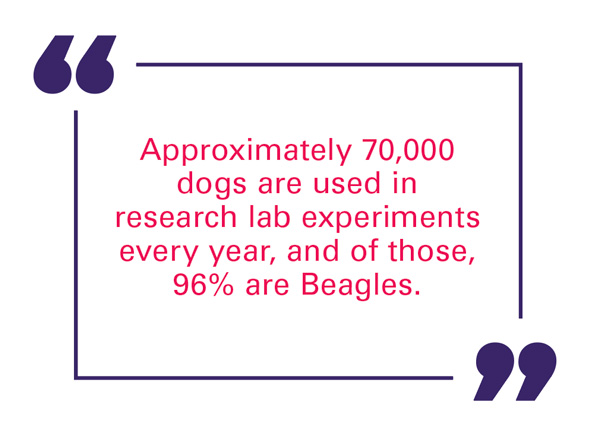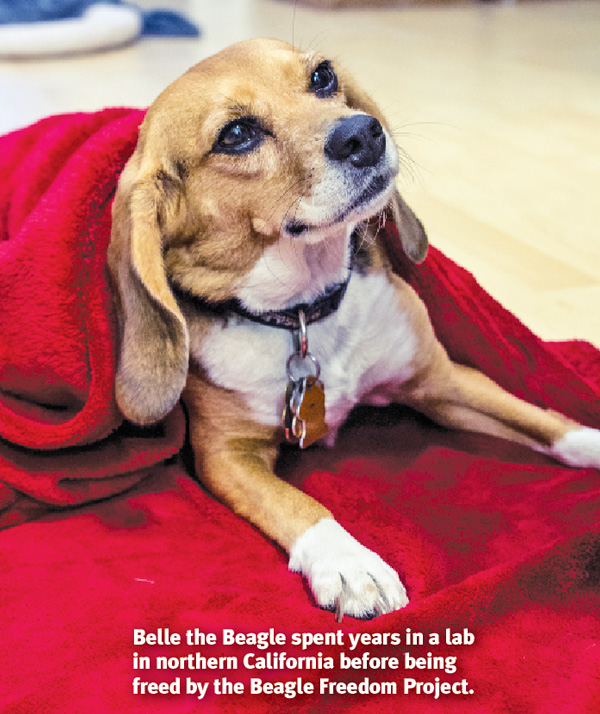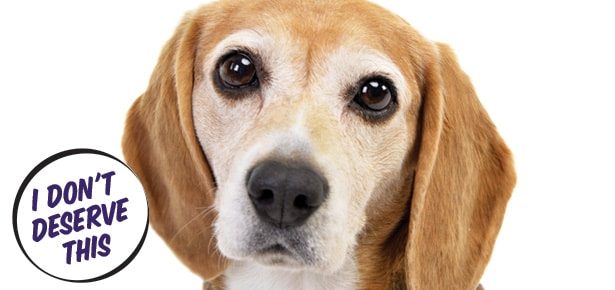
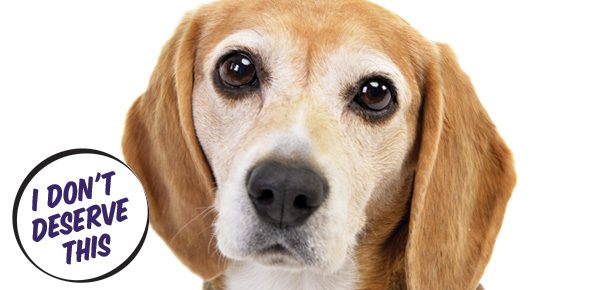
The Beauty Industry’s Dirty Little Secret
Your personal choices can help end animal testing. Here’s how.
Beasley the Beagle is a gentle and sensitive spirit. Rescued from a puppy mill in Missouri, it took time, love, and patience to coax the timid girl out of her shell. But the effort this took has been repaid thrice over: “Beasley has never met a dog or person that she doesn’t love. Even neighbours' cats come over to snuggle up,” says Beasley’s adopter Rhonda Zabinsky.
So when Zabinsky recently learned that thousands of Beagles just like Beasley are being held in laboratories and used in animal testing across the world, she was horrified.
The statistics are staggering: Approximately 70,000 dogs are used in research lab experiments every year, and of those, 96 percent are Beagles, according to the California-based Beagle Freedom Project (BFP).
Ironically and tragically, it is the breed’s trusting and loving nature that makes them “ideal” to be tested on when it comes to invasive and painful experiments. They are small, docile, and trusting of humans, meaning they are easier for lab technicians to handle.
Beagles used in lab testing live short and often very painful lives, often with little to no human contact other than being experimented on by technicians. The dogs are kept in metal cages with no opportunities for enrichment, playtime, exercise or socialization with other dogs. They have no name, no toys, and will never feel the grass beneath their feet.
“These are windowless facilities where dogs never get to go outside, they are never touched in an affectionate way, and for the most part dogs are being euthanized at the end of the testing,” said Lorna Campbell, Managing Director of the Beagle Freedom Project.
But while the use of dogs in testing is still quite common, it is rare for the public to know about it—and that’s exactly how the industry wants it.
Campbell says that’s because it’s not in a company’s interest for the public to know animals are used in cruel and painful tests. The vast majority of these tests happen behind closed doors, and most people are shocked to know that animal testing is still going on.
“Beagles really are the industry’s dirty little secret,” she said.
Humane Society International agrees, and notes there’s good reason for the secrecy: when people learn about testing they are overwhelmingly against it. A recent poll conducted by the group found that eight out of 10 consumers support a ban on animal testing of cosmetics and their ingredients.
But despite public objection, the practice is still very common.
The major reason that dogs and other animals, like mice, rabbits, guinea pigs, hamsters, and rats, are still used in testing for cosmetics, pesticides, toxicology, pharmaceuticals, and medical research is because it is legally required by the U.S. Food & Drug Administration and regulatory agencies despite the fact that proven, effective alternatives exist. 28 European Union nations, for example, have put in place bans on animal testing, yet in many cases, the FDA mandates obligatory animal testing before a new chemical, pesticide or pharmaceutical goes on sale to the public.
In Canada, animal research and testing is legal, although the decision falls on the company whether to use animals for cosmetic testing. Generally, animal testing is required in Canada for pharmaceuticals and medical research, says Humane Society International.
The battle to change this practice continues in both Canada and the US.
Last year, PETA and the Humane Society International succeeded in convincing the Canadian government to end its requirement that dogs be used in year-long pesticide tests, which experts have shown to be scientifically unnecessary—and useless.
In the pesticide testing, the dogs were taken from their mothers as puppies and fed pesticides every day for a year until they were killed and examined for organ damage and toxicity. The decision will save hundreds of Beagles from being killed every year in Canada. The U.S. outlawed the test in 2007.
Much like the outlawed pesticide testing, many of the tests done on dogs and other animals are archaic and no longer scientifically useful, say advocacy groups fighting to end animal testing.
There are also many sophisticated non-animal methods now available that are cheaper, faster, cruelty-free, and much more relevant to humans, says Jessica Sandler, Vice President of regulatory testing for PETA.
"Many animal tests that are being done today were developed around World War I and the early 1900s. We have to ask ourselves why there are so many technical innovations and this industry is still clinging to those old standards," she said.
"Technology is going to change the future of animal testing. Changing hearts and minds is a big first step."
PETA is among animal advocacy groups investing money, time, and research into developing non-animal testing methods that can be adopted by labs to speed up phasing out the use of animals.
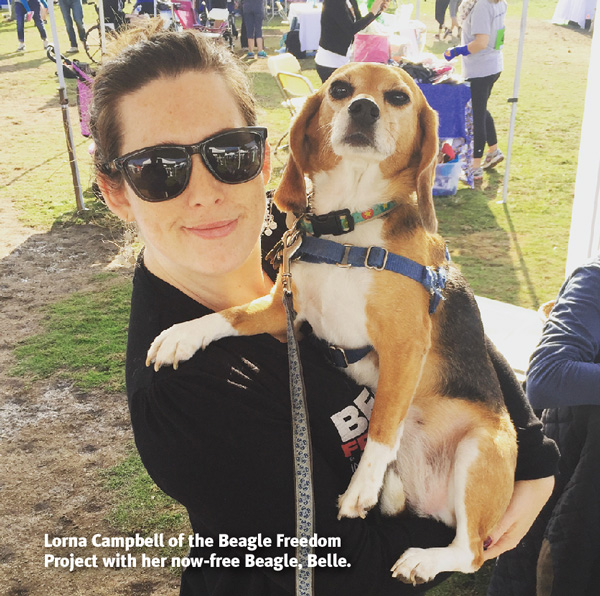
The organization has helped to pass the Beagle Freedom Bill in five states thus far: California, Nevada, New York, Minnesota, and Connecticut. The bill is simple but effective: If a lab uses taxpayer funds to use cats and dogs in their studies, the animals must be released to a rescue group at the end of the testing.
The Beagle Freedom Project has worked to re-home hundreds of lab dogs to loving guardians in the U.S., Canada, UK, and the Netherlands. BFP now reaches out to every lab in the U.S. asking to assist with post-research placements for its pups.
BFP’s Lorna Campbell says many labs are nervous about being exposed for keeping Beagles in their facilities, but despite this many labs and animal care technicians are now working voluntarily with BFP, or are compelled to do so because of the newly-passed bill.
Although every lab dog is different, the survivors share a common trait: They are like puppies in full-grown bodies. They aren't house trained and have never lived in a home nor known the love of a family or the warmth of a soft bed.
Lorna’s dog Belle spent years in a lab in Northern California. It took Belle months to seek out Lorna's affection but Belle and Lorna are now two of the charity's hardest working ambassadors.
"She was debarked in the lab so she can't communicate the way other dogs can. There are scars from that lab she will carry for the rest of her life. But she's happy now. And she's changed my life," she says.
Hope on the Horizon
There is hope on the horizon when it comes to ending animal testing and consumers hold a lot of power because they can vote with their pocketbook.
More than 600 beauty brands around the world are now recognized as cruelty-free, meaning they do not conduct or commission new animal testing and only use ingredients that can be deemed safe without animal testing. (See sidebar “Easy-to-find brands that don’t test on animals”)
The Humane Society International has just launched #BeCrueltyFree, the largest campaign in history to end animal testing for cosmetics. Its aim is to give the beauty industry a makeover by spearheading negotiations with governments and companies to close the door on cruel, archaic, and largely unnecessary cosmetic animal testing.
Already it has helped to implement two levels of bans for cosmetic animal testing in 28 European Union countries, New Zealand, and South Korea, and is working on legal reforms in North America and abroad.
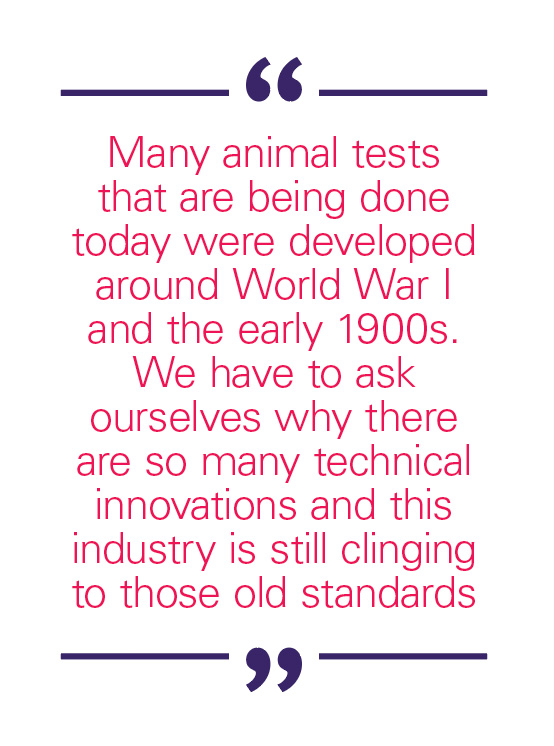
HSI is asking U.S. animal lovers to use its website, humanesociety.org, to send a note to their local legislative representative to endorse the Humane Cosmetics Act, which would prohibit animal testing for cosmetics manufactured or sold in the U.S.
The hope is this act will finally end cosmetic animal testing in the U.S., just like in more than 30 countries where it’s already been phased out, including the EU, Norway, Israel, Switzerland, and India.
Meanwhile in Canada, Rhonda, who we introduced you to at the beginning of this article, was so outraged to learn of the common use of Beagles in testing, that she launched an online petition calling on Canada to ban animal testing by 2020. It was signed by more than 10,000 supporters in just a few days.
She's also just launched a parliamentary e-petition, and if it garners enough signatures it will be presented in front of the government's House of Commons.
"These animals cannot speak for themselves. I couldn't just sit by," Rhonda said, bringing to mind the words of Margaret Mead:
“Never doubt that a small group of thoughtful, committed, citizens can change the world. Indeed, it is the only thing that ever has.”
Cruelty-free consumerism: Brands that don’t test on animals
Make your consumer dollar count!
These easy-to-find brands don’t test on animals:
And remember: You vote with your wallet. Contact your favourite brands to ask whether the company animal tests its products or ingredients. Urge them to make the leap to going cruelty-free, or buy elsewhere.
Resources
Leaping Bunny has an online shopping directory of companies that don’t test on animals. It also offers exclusive discounts for Leaping Bunny certified products.
PETA has a comprehensive database of 2400 companies that are cruelty-free, including cosmetics, personal-care products, household-cleaning products, and other common household products.
Cruelty-cutting On The Go
If you’re unsure about whether a product is tested on animals, use the Beagle Freedom Project’s Cruelty-Cutter smartphone app. Simply scan the item in store and you’ll get an immediate response about its animal testing status. Download it at: cruelty-cutter.org.
Join the newsletter and never miss out on dog content again!
"*" indicates required fields
By clicking the arrow, you agree to our web Terms of Use and Privacy & Cookie Policy. Easy unsubscribe links are provided in every email.
